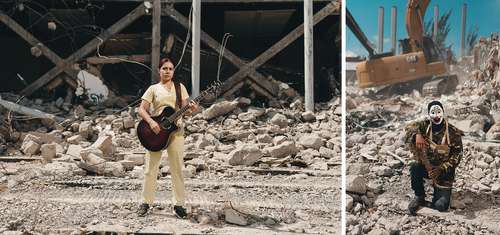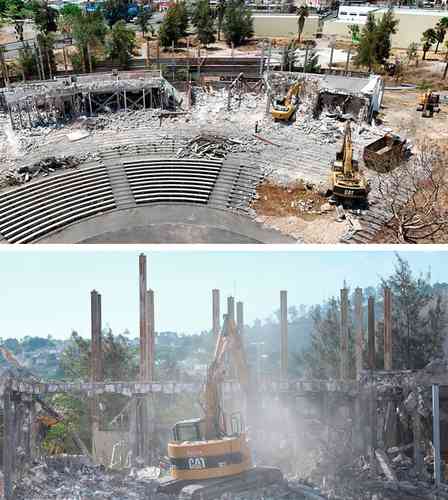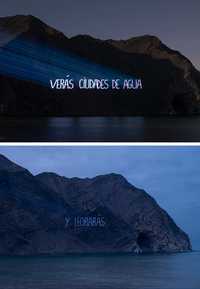In the Cobá ejido, they agree to continue with the Promeza infrastructure works.

In the Cobá ejido, they agree to continue with the Promeza infrastructure works.
From the editorial staff
La Jornada Newspaper, Thursday, June 12, 2025, p. 3
Following a meeting between members of the Cobá Ruins ejido, chaired by Commissioner José Waldemar Cen, and members of the National Institute of Anthropology and History (INAH), headed by its general director, Diego Prieto Hernández, it was decided to continue construction of the infrastructure projects that are part of the Archaeological Zones Improvement Program (Promeza) in this town located in northern Quintana Roo.
The works consist of the construction of the service unit, protective roofs for monuments, paths, signage, as well as the consolidation and adaptation of the staircase of the main building, known as Nohoch Mul, to allow visitors to ascend and descend safely, but without affecting the archaeological heritage.
Promeza was implemented in 29 archaeological sites in the southeast of the country, 11 of which are in Quintana Roo, and was completed in approximately three months.
In his speech, Prieto Hernández highlighted the historical importance of Cobá as one of the most important metropolises of the Mayan civilization, which flourished between 600 and 1000 AD.
This city witnessed the rise of Petén-style buildings with Eastern Coast influence and the network of sacbé roads, one of which is 100 kilometers long and reaches as far as the outskirts of Chichén Itzá.
In his speech to the ejidatarios, the project manager, Manuel Pérez Rivas, highlighted that according to the most recent research findings, four women governed Cobá, one of them for a period of 40 years: This shows that the power exercised in the Mayan civilization was not exercised only by men, which denotes the openness in the social and political organization of the ancient Mayan nation, whose memory remains alive today
.
Protests in Tepic against the destruction of the City of the Arts

▲ Amidst the rubble of benches and walls, local artists have performed, expressing their discontent with the construction of a sports facility where an amphitheater and music school once stood. Photo courtesy of Efraín Arcadia O'Connor

▲ With an investment of 315 million pesos, the Nayarit government set out to build a stadium that would house a second-division soccer team. Photo Images courtesy of Nayar
Myriam Navarro
Correspondent
La Jornada Newspaper, Thursday, June 12, 2025, p. 4
Tepic, Nay., The works to build the Nicolás Álvarez Ortega (NAO) soccer stadium in the Estadios subdivision in Tepic, provoked ongoing protests from the cultural and environmental community, who on the one hand denounce the destruction of an amphitheater, a space for skateboarding , a music school (still standing), and the removal of trees and palm trees that were there until almost two weeks ago, but there are also those who defend the construction of what will be a sports space.
The NAO was demolished in 2009 by the then-governor of the state, Ney González Sánchez, who planned to carry out other projects in the 25,000-square-meter space, which never came to fruition.
The demonstrations were peaceful and very meaningful. Young artists demonstrated their skills among the rubble of benches and collapsed walls. A musician played his violin amid the destruction, while a ballet dancer, dressed in her costume, performed for those who wished to admire her.
They also went to Benito Juárez Plaza, located in front of the Government Palace, and raised their voices and banners to stop the work carried out by the Nayarit government.
Alejandro Carrillo, a violinist who is among the young people on guard requesting signatures to stop the construction, points out that this space is filled with culture and love for the environment. He adds that they will not move from this area and try, to the best of their ability, to stay 24 hours a day. "We are here raising our voices so that it is not destroyed and that it is preserved as such, because it is a beautiful place. There have been several artistic demonstrations with the participation of DJs and poets, in addition to dialogue among ourselves."
Musician Andrey Medina Reséndiz echoes his colleague's words: we don't want the City of Arts to be destroyed and the environment to be damaged, because these are the things we must continue to preserve today, especially for the future of society. We are speaking out to prevent this from being destroyed simply for the whim of wanting a stadium when it's no longer necessary. I mean, we already have Cora Stadium, Santa Teresita Stadium, and another baseball stadium; another one isn't feasible
.
They say they have so far collected more than 4,000 signatures seeking protection from the law and to prevent further demolition
.
On May 31, when the NAO project began, Raquela Araujo, head of state infrastructure, announced that 16,700 square meters of land would be built on 25,000 square meters, with a capacity for 12,564 spectators. The existing 196 trees would be relocated by the Nayarit Forestry Commission to other parts of Tepic. She added that construction of the NAO would take 18 months and require an investment of 315 million pesos. This will allow Nayarit to have a stadium capable of hosting a second-division team, in accordance with FIFA requirements. It will also house the State Music School in a 600-square-meter area, as well as a hall of fame.
That same day, former professional soccer player Marcelino Bernal, originally from Nayarit, stated: "The truth is that this news makes us very happy because this was our home, a stadium that is an icon of the city. Many of us who are here were born here in football. We all have a story; it's truly gratifying and beautiful to know that this stadium, where we experienced many joys and sorrows, like everywhere, is going to be rebuilt. But it was our special place to come and watch football
."
Antonio Arredondo Bertrand, a sportswriter for over 40 years in Nayarit and a professor at the Autonomous University of Nayarit, says he can't forget the feeling of sadness and melancholy when he saw the machines demolish the old NAO in 2009; today, he adds, there shouldn't be a conflict between culture and sports.
Secretary General of Government Rocío Esther González García commented that the stadium isn't destroyed, it's transformed, and that it was a repeated campaign request to current Governor Miguel Ángel Navarro Quintero, who is keeping his promise to rebuild this iconic soccer venue.
You'll see: Raúl Zurita's latest project will be presented at Casa del Lago
The Chilean writer's initiative is the third action that fuses poetry with space
Reyes Martínez Torrijos
La Jornada Newspaper, Thursday, June 12, 2025, p. 5
Last year, Chilean author Raúl Zurita wrote
a poem about light on a cliff on the coast of his country as a way of realizing the dream that one day humanity will be worthy of the universe it inhabits, which seems increasingly distant
.
The poet explained that it is a sign that no one deserves this reality , so heartbreakingly overflowing with rubble and blood
, which was conceived almost a quarter of a century ago.
On Saturday, UNAM's Casa del Lago will present Verás: El último proyecto (You'll See: The Last Project) , a record of this action, with images, an experimental video, and a short film, before premiering a documentary in October.
The original initiative was realized with the support of the artistic collective Delight Lab (owned by siblings Andrea and Octavio Gana) and the Engel Foundation, in Caleta Vítor, in the south of the province of Arica. This is the third time the author's poetry has been fused with space, along with La vida nueva (New Life ), projected in the sky of New York (1982), and Ni pena, ni miedo (No Pain, No Fear, No Fear, No Fear, No Fear, No Fear, No Fear, No Fear, No Pain ... Fear, No Pain, No Fear, No Fear, No Fear, No Fear, No Pain, No Fear, No Fear, No Fear, No Pain, No Fear, No Fear, No Fear, No
In the most recent project, 22 verses of the poem were projected onto an 800-meter-high cliff, each about 300 meters wide. It began at sunset and ended at dawn, when the last line of the poem was suspended on a cliff in Caleta Vítor until the rising of a new sun extinguished it.
The phrases in the sky fade away, disappearing like a dream, like everything else. In the desert, they will also eventually fade away, fading away. The 22 phrases lasted an afternoon, a night, and a morning. Very few of us saw them, but through them, we see all of humanity, all that we are, all we have suffered and cried for, and our dreams, hopes, and embraces. When I think about it, I feel like crying because I am sentimental.
Zurita (Santiago, Chile, 1950) explained that with the phrases in Verás , “I thought I had worked with my life in that sense and I had to close it with my death. It's a concrete fact, without any drama, one day you're going to disappear. I came up with these 22 Verás , which are how I imagine what one will see in their passage on this earth. They are allegorical, but more or less what all human beings will see.”
The occasion was exciting and instantaneous; around 40 people saw it and felt an even greater intimacy. These seemingly monumental things are actually the most intimate, because they lived inside you for so long. You live with it for many years, imagining it, until it was realized thanks to so many people
, the writer commented.
Revelation in Mexico City
The 2020 Reina Sofía Prize winner for Ibero-American Poetry shared a revelation when he visited Mexico City years ago and saw a photograph of the Mexican Revolution that had a profound impact on him. He had already been thinking about writing a few lines, and it instantly occurred to him.

▲ In Caleta Vítor, in the south of the province of Arica, Chile, Raúl Zurita projected 22 verses of his own poem as a way of realizing the dream that one day humanity will be worthy of the universe it inhabits, which seems increasingly distant
. Photo courtesy of UNAM Culture
“I am, or believe myself to be, or presume to be a poet. My work is with words. Suddenly I saw the sky and said, 'It would be a beautiful place to write a poem.' It belongs to a certain feeling of guilt, collective and private at the same time, for the horror we are making of this world. In these 22 sentences, there is also a certain disillusionment. It ends with 'And you will cry,' when everything is fading away.”
He reflected that "poetry is precisely the hope of those who have no hope, it is the love of those who are forever deprived of love, the possibility of those who have no possibility. If, as Marx said, 'religion is the heart of a heartless world,' I think poetry is doubly so. The final dream is a dream that suddenly clings sadly and painfully to half-open eyes amidst the rubble. I imagine what that must be like."
The only thing I want to think and believe is that if the last moment of any human being's life is under the conditions in which they die, under torture or any of the methods this devilish humanity has invented to inflict on one another, I hope that last second is one of peace and contentment, that their spirit has been touched. If everyone is dead and doesn't have a last second of happiness, then this life is truly worthless.
Raúl Zurita admitted his heart's hunger to break the terrible universe, even though that possibility has been denied a million times. Poetry, he asserted, cannot stop a war, a country from being bombed, or a people from being exterminated, but without it, no transformation is possible. It's quite concrete. If poetry ceases, it means that all men and women have been left without dreams
.
The renowned author commented that the mere fact that a human being dreams of doing something is enough, because "I have had amazing things that will die with me and I will be the only one, like each one of us, who will read that incredible novel and poem that we had never written, but that we have only dreamed of.
That's not the privilege of an artist, but of all human beings. Each of us comes up with millions of novels in a second, we dream the wildest dreams, incredible phrases fluttering over the peaks of the Andes, poems stretching out over the ocean. And why not leave it just on paper? I don't know. I suddenly need that to reverberate, even if only in me, to resonate like the surf crashing against the waves. Dreams are that remnant of passion that can't be consummated during the day.
Cinthya García Leyva, owner of Casa del Lago, announced that before the opening of the exhibition at the Chapultepec gates, curated by Fernanda Dichi and Maria Pies, which will run from Saturday to December 19, a short film will be screened before the documentary, which will premiere in October at the Poesía en Voz Alta festival. All activities at this venue are free.
jornada



